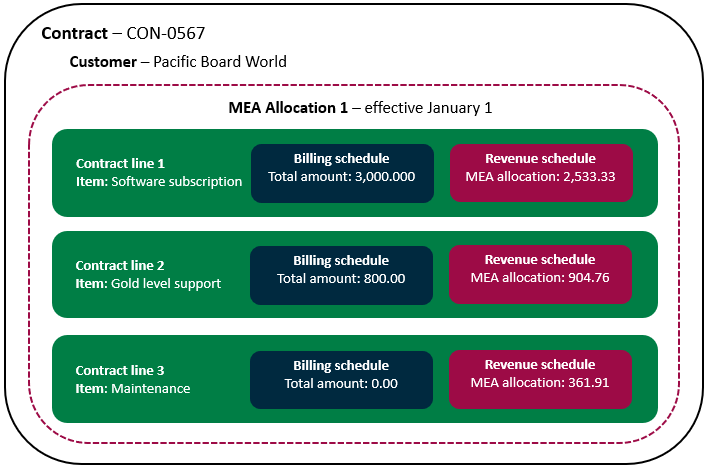About MEA allocations—Contracts
Multiple-element arrangements (MEAs) are two or more distinct performance obligations associated with the same contract. The bundle's transaction price is allocated to each performance obligation based on its relative standalone selling price and is recognized when each deliverable is satisfied.

If your company provides multiple products or services to customers as part of a single arrangement, you will group the applicable contract lines into one or more bundles in a contract. When you execute the MEA allocation on a bundle, Intacct uses the items' fair value prices from the applicable MEA price list to allocate the total bundle contract value between the participating contract lines.
The allocated MEA amounts are then recognized according to the revenue schedules associated with the applicable contract lines.
How the MEA amount is calculated
The following is the basic calculation for allocating revenue in an MEA in a contract:
The calculation is different if the MEA contains items priced as "No fair value", as then the MEA is allocated using the Residual method. See MEA allocation calculation examples for examples of different MEA allocation scenarios.
About MEA allocation adjustment types
An MEA allocation will result in an adjustment to any in progress revenue schedules associated with participating contract lines. There are two ways you can choose to apply the adjustment:
- One time
- Distributed
All MEA allocation schemes applied to a particular revenue journal for a contract require the same Adjustment type. For example, if you select "One-time" as the Adjustment type for the first MEA allocation applied to Journal 1, then all subsequent MEA allocations applied to Journal 1 require that the Adjustment type be "One-time".
One time
This adjustment type schedules the net difference between any prior posted periods and the current allocated scheduled amount to be recognized in the month of the applicable MEA allocation Effective date. This can result in a positive or negative posted amount.
Distributed
This adjustment type schedules the net difference between any prior posted periods and the current allocated scheduled amount evenly across the remaining revenue schedule. If the revenue term contains partial periods, the net amount is subject to proration.
For example, say one of the contract lines in the MEA was allocated with additional revenue after three periods of revenue had posted. The MEA allocation process divides the additional amount by the number of periods left in the schedule and adds the adjustment to each period, as in the following example:
